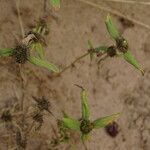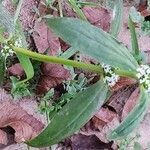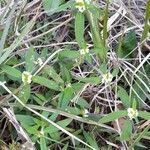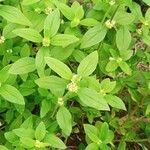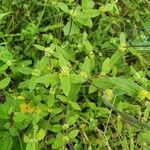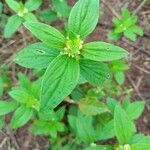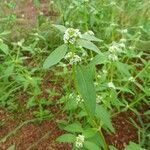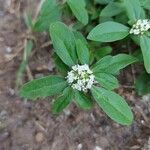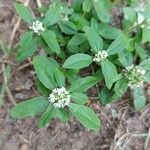Herbs, annual, branched, 40-80 cm tall; branches flattened to subterete or 4-angled, sometimes becoming woody in lower part, sparsely hirsute to villous. Leaves sessile; blade drying thinly papery, elliptic-oblong or lanceolate, 3-4.5 × 0.7-1.5 cm, adaxially scaberulous and usually also sparsely villosulous or pilosulous, abaxially moderately to densely villous or pilose, base acute to obtuse or rounded, apex acute; secondary veins 3-6 pairs; stipule sheaths 1-4 mm, villosulous or pilosulous to glabrescent, with 1-9 setae 1-5 mm. Inflorescences 5-20 mm in diam. (not including subtending leaves), villosulous or pilosulous; bracts linear, 1-2 mm. Calyx sparsely to densely puberulent or strigillose; ovary portion subglobose to ellipsoid, ca. 0.5 mm; limb deeply lobed; lobes unequal, triangular to lanceolate, 2 larger 1.8-2 mm, 2 smaller 0.8-1.2 mm, ciliate. Corolla funnelform, outside puberulent to glabrous; tube 1-1.5 mm, glabrous inside; lobes triangular to ovate, 0.5-1 mm, obtuse to acute. Capsules subglobose, ca. 1 mm in diam., scaberulous or sparsely puberulent; seeds dark brown, oblate-suboblong, ca. 0.8 mm. Fl. and fr. Apr-Nov.
Leaf blades 1–6 x 0.3–2.3 cm., elliptic, subacute at the apex, cuneate at the base, glabrescent to scabrid-pubescent above, glabrescent or glabrous beneath save for hairs on the main nerves; margins often scabrid; petiole c. 1 mm. long, often densely pubescent and with ciliate margins; stipule sheath 1–3 mm. long, divided into 6–9(15) often colleter-tipped fimbriae, 1–5 mm. long, ciliate.
Seeds pale yellow-brown, 0.8 x 0.5 mm., compressed ellipsoid-rectangular, of very characteristic appearance (see TAB. 42, fig. 10.), dorsally resembling a rectangle with a square portion removed from each corner, ventrally separated into 4 distinct areas by 4 impressed lines radiating from the hilum, rugulose and reticulate.
Calyx tube 1–1.4 mm. long; limb tube 0.15–0.4 mm. long; lobes 4, 2 oblong-lanceolate, green with hyaline margins, rather thick, 1.3–2.3(3) mm. long, and 2 hyaline, 0.55–1.5 mm. long, triangular-lanceolate, narrower than the others, all with usually ciliate margins and often hairy below.
Erect or spreading annual herb (5)9–40 cm. tall, with unbranched or sparsely to much-branched stems; branchlets pubescent with short curled ± appressed hairs and often with spreading ones as well, the older with epidermis eventually peeling; sometimes quite woody at the base.
An erect herb. It grows 10-40 cm tall. The stems has few branches. The leaves are narrowly oval and 1-6 cm long by 0.5-2 cm wide. There are flowering groups in the axils of the leaves.
Inflorescences numerous, present in most axils, subglobose, (0.5)0.8–1.8 cm. in diam.; flowers sessile or almost so; bracteoles filamentous, white, 1–2 mm. long.
Flowers showing very slight heterostyly, the anthers varying in their degree of exsertion; style 1.1–1.6 mm. long; stigma 0.3–0.5 mm. long.
Corolla white, glabrous or slightly hairy outside; tube 1.4–1.9 mm. long; lobes 0.6–1 x 0.3–0.9 mm, ovate.
Capsule straw-coloured, c. 1 mm. long and wide.
